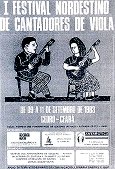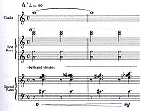Brazilian Musics, Brazilian Identities Special issue of the British Journal of Ethnomusicology 9(1), 2000, edited by Suzel Ana Reily, 167 pp., illustrations, paper, 15.00 GBP. Printed by Hobbs the Printers Ltd., of Totton, Hampshire. Sold by RMS Dooley, Crag House, Witherslack, Grange-over-Sands, Cumbria LA11 6RW England. Tel.: + 44 (0) 15395 52286. Fax: + 44 (0) 15395 52013. Email: musicbks@dooley.demon.co.uk. |
|
In order to expand British Journal of Ethnomusicology and enhance its international profile, the editorial board has taken the decision to publish, annually, one issue devoted to a specific theme, to be followed by a second one of a more general nature. Brazilian Musics, Brazilian Identities is the first of such thematic issues. As Suzel Ana Reily and Martin Clayton state in the Editorial, "each article focuses upon a particular musical universe, looking at how it articulates with the construction of identities within a specific sector of Brazilian society." Geography, however, is not the primary preoccupation: the issue has been conceived as illustrative of how recent debates on the musical construction of identity within ethnomusicology are informing research in a specific national context. In Reily's and Clayton's view, while most ethnomusicologists know very little about the work of Brazilian musicologists, these, on the contrary, "are very much aware of the latest academic trends emerging at the center." And, "as the center moves progressively toward an academic style in which ethnography is drawn upon primarily as a means of illustrating a particular theoretical perspective, in Brazil … it is the theoretical models that are fitted to the ethnography." Herein, they believe, lies the interest of the Brazilian contribution. Reily holds a Ph.D. in Social Anthropology from the University of São Paulo (USP) and is Senior Lecturer in Ethnomusicology and Social Anthropology at the Queen's University of Belfast. As Reily states in "Introduction: Brazilian Musics, Brazilian Identities" (pp 1-10), although musical accounts by missionaries, travelers and local residents date back to colonial times, conscious investigation of Brazilian music by Brazilian scholars is a relatively recent phenomenon that was instigated by the emergence of nationalist sentiments and started taking shape with the work of Mário de Andrade (1893-1945). To give readers a clearer idea of how the contributions in her volume relate to ongoing debates in Brazilian intellectual circles, she provides an overview of musical research in Brazil. Stressing "the myth of tri-racial ethnicity," according to which Brazilian music would be "the loving flower of three sad races" (namely Amerindians, Africans and the Portuguese, as evoked in the final verse of the Parnassian poet Olavo Bilac's "Música brasileira"),[1] she makes an important point:
The extent to which the combined mystiques of tri-racial ethnicity and progressive nationalization hold sway may be inferred from the fact that Reily "had intended to invite a Brazilian scholar to write on the musical activities of one of the major immigrant groups in the country, but there was no one conducting such research." "Música Romântica"[romantic music] in Montes Claros: Inter-Gender Relations in Brazilian Popular Song" (pp 11-40), by Martha Tupinambá de Ulhôa, from the University of Rio de Janeiro (Uni-Rio), unfolds in two sections. In the first, Ulhôa draws the reader's attention to the history of social life in Montes Claros, from its origins as a center where, in the late 18th century, the rural aristocracy would come to attend the monthly mass, to the mid 1960s, when, under the military dictatorship, "young people began to gather at bars and pizzerias." In the second section, she analyzes three examples of romantic song that
were likely heard in Montes Claros in the last hundred years: "Amo-te muito"[4],
by João Chaves (Audio 1), "Vingança", by Lupicínio Rodrigues, in Linda
Batista's 1951 interpretation (Audio 2), and "Detalhes", by Roberto Carlos and Erasmo
Carlos, in Roberto Carlos's 1971 interpretation (Audio
3). Each section tackles a
different object (social life in Montes Claros and a set of songs) according to a
different method (ethnography and semiotic analysis of song lyrics). What connects
them is the focus they share on inter-gender relations and the diachronic nature
of Ulhôa's approach. |
|
|
In "Gaucho
Musical Regionalism" (pp 41-60), Maria Elizabeth Lucas, from the Federal
University of Rio Grande do Sul (UFRGS), shows how, in the bosom of one of
the areas in the country where income is best distributed, the stigma of
coarseness has been raised to the status of a regional emblem. Focusing on
the ways in which her case-study responds "to the conditions brought about
by transnational capitalism," Lucas describes the roots of gaucho identity
and its enactment in nativist music festivals, where between two and
fifteen thousand white middle-class urbanites gather within a two to four
day festive frame, eager to cultivate rural traditions by displaying
markers of "gaúcho-ness." Male gaucho identity, of which it is a
question here, is stereotypical to the point of being perceived as caricatural even in the context of the highly polarized Brazilian gender
system. Gender issues, however, are not on Lucas's agenda. |
|
|
|
Translated by Reily, "Ethics in the Sung Duels of North-Eastern Brazil: Collective Memory and Contemporary Practice" (pp 61-94), by Elizabeth Travassos, from the University of Rio de Janeiro (Uni-Rio), provides descriptions of sung poetic competitions in which two singers play guitar-like instruments and attempt to outdo one another in the art of verse improvisation. For Travassos, the vitality of this tradition is closely linked to the ethics that structure its performance. "On entering the performance arena, they (viz. the singers) must strive to suspend their everyday social identities, neutralizing these attributes to engage with one another as poets, that is, as 'equals'." In other words, "the real advantages that the rich have over the poor, whites over blacks, the educated over the illiterate, men over women can be reversed through talent in the art of verse improvisation." Combining vivid description of performances and characters with insightful observation, unhindered by extraneous constructs, Travassos puts together a beautiful piece of writing, one in which the question of identities starts making way for the perhaps more pressing question of Brazilian subjectivities. |
|
|
|
|
Fig. 3. A sample of Paschoal's eccentric orchestration: an excerpt from his "Cores," for cicada, two pianos, bells and whistles. |
Translated by Reily, "The Experimental Music of Hermeto Paschoal e Grupo (1981-93): A Musical System in the Making" (pp 119-42), by Luiz Costa Lima Neto, from the Martins Pena State School of Theatre, offers an insight into the "eccentric" compositional techniques employed by Paschoal and his group in the making of their "anti-commercial" music. The "authenticity" of Paschoal's project, the author believes, "would be structured around eccentricity, the (natural) sounds of everyday life and (non-commercial) virtuosity." A digression into the spectro-morphology of noises, however, interrupts the flow of Costa Lima's exposition with periclitating handling of electroacoustic terminology. One is left wondering why the discussion of Paschoal's use of iron rods as sound-producing objects has to happen with reference to Jonathan Harvey's recording of the 33 inharmonic partials of the great tenor bell of Winchester Cathedral as analysed by Fast Fourier Transform for use in his 1980 IRCAM commission.[5]
|
|
The thematic section concludes with a review-essay on Jean-Michel Beaudet's Souffles d'Amazonie: les orchestres tule des Wayãpi (1997) by Rafael José de Menezes Bastos, from the Federal University of Santa Catarina (UFSC), and Acácio Tadeu de Camargo Piedade, from the State University of Santa Catarina (UDESC). Ethnomusicology in Brazil has played a leading role in the development of the musicological discipline, by and large dominated by editions of so called baroque music, mythologizing narratives of "great composers" lives, dutiful exegeses of the Nationalist/Modernist leitmotif and purportedly emic approaches to the musics of aural tradition. Whether the apparent contradiction between the reference frames of Ethnomusicology and those--"eclectic and selectively pluralistic", as Agawu has put it[6]--of the New Musicology will pose a threat to that leadership, it remains to be seen. A glance at the programs of the Society for Ethnomusicology 2001 meeting and of the British Forum for Ethnomusicology one-day conference at Royal Holloway the same year shows that, in the Northern hemisphere, miscegenation is already taking place. Would a methodological symbiosis be looming in the horizon of antropofagismo?[7] Be that as it may, the presence of Hosokawa's essay in Reily's volume suffices to indicate the predictability of the places at which Brazilian scholars have looked in their quest for musical otherness. The time seems ripe for Brazilian musicologists to take stock of subjects, trajectories and methodologies. To this end, Brazilian Musics, Brazilian Identities is a generous and most valuable contribution. Notes 1. Portuguese text and English translation of Bilac's poem. 2. João Hernesto Weber, A nação e o paraíso: a construção da nacionalidade na historiografia literária brasileira, Florianópolis: Editora da Universidade Federal de Santa Catarina, 1997. 3. Suzel Ana Reily, "Introduction: Brazilian Musics, Brazilian Identities", British Journal of Ethnomusicology 9(1) (2000): 6. Reily observes that various non-Brazilian scholars, among which Appleby, Béhague, McGowan and Pessanha, Schreiner, and many others, have replicated that canon. 4. Ulhôa does not refer to any particular recording of this song; the excerpt herein, featuring Tadeu França, has been taken from a performance by Saulo Laranjeira and Tadeu França. 5. For an enthusiastic review of Costa Lima's article, see David Treece in the August or November issue of the Journal of Latin American Studies, volume 4, number 3 or 4, 2002 (in press). 6. Kofi Agawu, "Analyzing Music Under the New Musicological Regime", Music Theory Online 2 (4), par. 7, 1996. 7. For an English translation of
Oswald de Andrade's 1928 Anthropophagite Manifesto, see
http://www.nmu.edu/www-edgar/language/Martin/anthropofagia.html; for a
critical reading of antropofagismo, with reference to
North-American affirmative action politics, see Heloísa Buarque de
Hollanda's "The Law of the Cannibal or How to Deal with the Idea of
'Difference' in Brazil", originally a talk given at New York University in
May 1998,
http://acd.ufrj.br/pacc/paper1.html and
http://acd.ufrj.br/pacc/literaria/paper1helo.html. review | EOL 8 | email author | review editor released 11 December 2002 |
|



